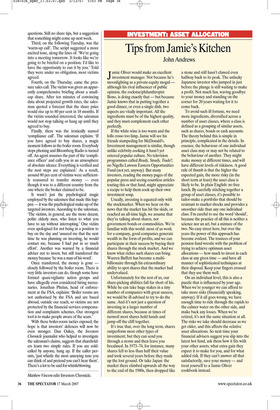Tips from Jamie’s Kitchen
John Andrews
Jamie Oliver would make an excellent investment manager. Not because he’s moonlighting as a private-equity mogul although his rival influencer of public opinion, the rockstar/philanthropist Bono, is doing exactly that — but because Jamie knows that in putting together a good dinner, or even a single dish, two aspects are vitally important. All the ingredients must be of the highest quality, and they must complement each other perfectly.
If the white wine is too warm and the lollo rosso too limp, Jamie will see his friends stampeding for McDonald’s. Investment management is similar, though unlike celebrity cooking it hasn’t yet entered popular culture. No television programmes called Ready, Steady, Trade!; no Nigella Lawson Eastern Opportunities Fund (not yet, anyway). But many investors, reading the money pages of the popular press and seeing countless articles touting this or that fund, might appreciate a recipe to help them cook up their own investment soup.
Usually, investing is equated only with the stockmarket. When we hear on the news that the market has hit the skids, or reached an all-time high, we assume that they’re talking about shares, not government bonds or commodities. We’re familiar with this world: most of us work for a company, good companies generate wealth in the form of profits, and we can participate in their success by buying their shares through the stock market. And we know what riches such shares can bring. Warren Buffett has become a multibillionaire through his extraordinary ability to spot shares that the market had undervalued.
Unfortunately for the rest of us, our share-picking abilities fall far short of his. While he can take huge stakes in a tiny number of companies with great success, we would be ill-advised to try to do the same. And it’s not just a question of investing in a larger number of different shares, because at times of turmoil most shares hold hands and jump off the cliff together.
It’s true that, over the long term, shares outperform most other types of investment; but they can send you through a storm and then leave you becalmed. In 1973–74, for instance, many shares fell to less than half their value and took several years before they made up the lost ground. Or take Japan: the market there climbed upwards all the way to the end of the 1980s, then dropped like a stone and still hasn’t clawed even halfway back to its peak. The unlucky Japanese investor who jumped in just before the plunge is still waiting to make a profit. Not much fun, waving goodbye to your money and standing on the corner for 20 years waiting for it to come back.
To avoid such ill fortune, we need more ingredients, diversified across a number of asset classes, where a class is defined as a grouping of similar assets, such as shares, bonds or cash accounts. The theory behind this is simple in principle, complicated in the details. In essence, the behaviour of one individual asset class may or may not be related to the behaviour of another. They might make money at different times, and will have different levels of riskiness. A good rule of thumb is that the higher the expected gain, the more risky (in the short term at least) the asset class is likely to be. In plain English: no free lunch. By carefully stitching together a group of asset classes, it’s possible to tailor-make a portfolio that should be resistant to market shocks and provides a smoother ride than any one individual class. I’m careful to use the word ‘should’, because the practice of all this is neither a science nor an art, but a mixture of the two. No easy street here, but over the years the power of this approach has become evident. The trustees of your pension fund wrestle with the problem of trying to achieve optimum asset allocations — how much to invest in each class at any given time — and have all manner of sophisticated techniques at their disposal. Keep your fingers crossed that they use them well.
On an individual level, this is also a puzzle that is influenced by your age. When we’re younger we can afford to take more risks (financially speaking, anyway). If it all goes wrong, we have enough time to ride through the rapids to the calmer water on the other side, and make back any losses. When we’re retired, it’s not the same situation at all. The risks we take should decrease as we get older, and this affects the relative asset allocations. So next time your financial advisers suggest you slip into the latest hot fund, ask them how it fits with your other assets, what extra gain they expect it to make for you, and for what added risk. If they can’t answer all that satisfactorily, save your money — and treat yourself to a Jamie Oliver cookbook instead.


































































































 Previous page
Previous page